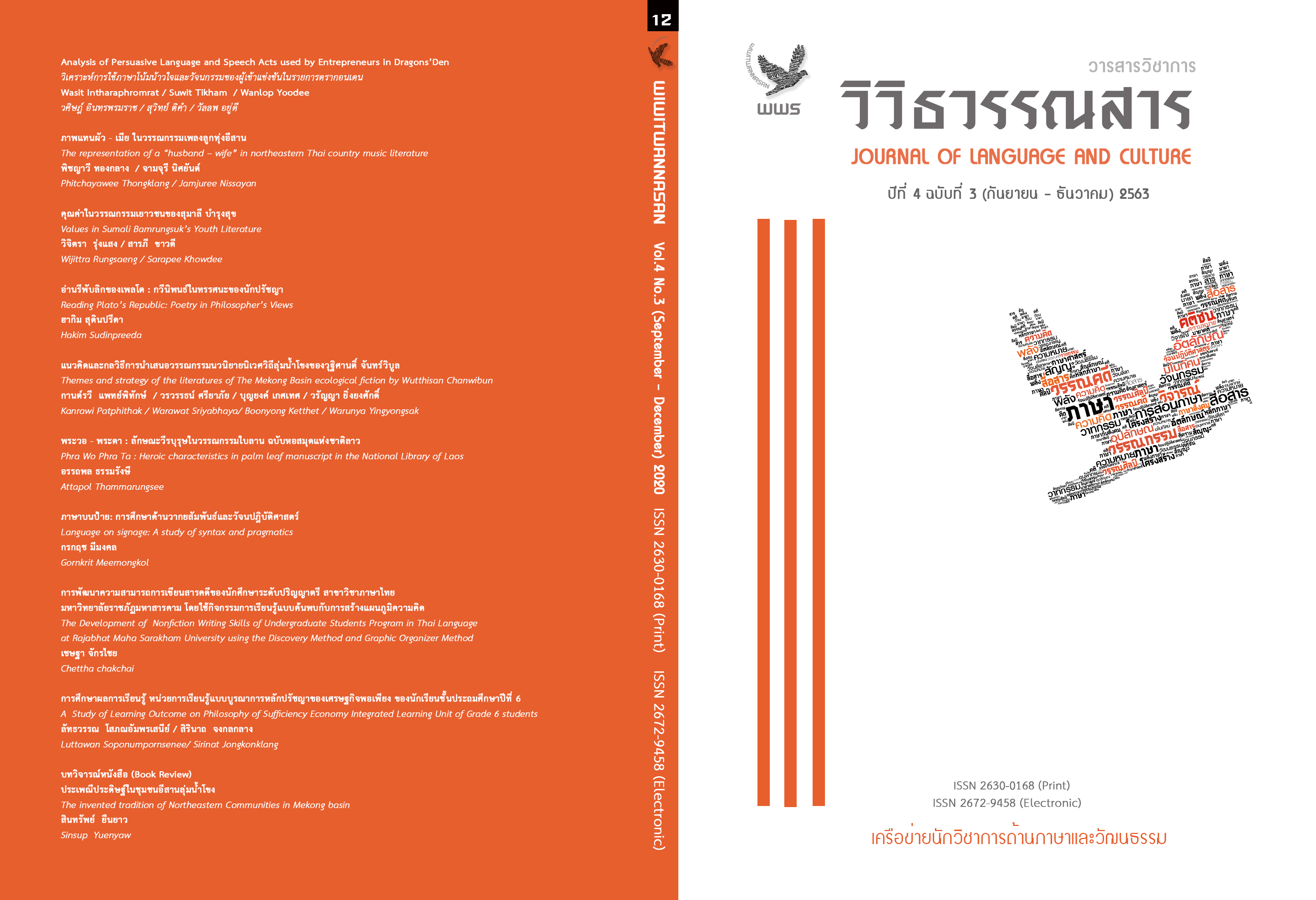Use of persuasive language and speech acts in Dragons' Den
Main Article Content
Abstract
This study aimed to study the Persuasive Strategies and Speech Acts used by the entrepreneurs in Dragons’ Den the Series 17th from Episode 1 to Episode 10, and to identify the use of Persuasive Strategies and Speech Acts used in Dragons’ Den. The data was collected from 10 video clips in Dragons’ Den The Series 17th from Episode 1 to Episode 10 in the first three minutes of pitching by the entrepreneurs in Dragons’ Den Channel. This mixed-method study utilized both quantitative and qualitative research including investigating the frequency of Persuasive Strategies and Speech Acts in each clip. Moreover, all transcribed speeches were analyzed qualitatively. The Persuasive Strategies theory were employed from Lucas (2009) which consists of Logos, Pathos and Ethos respectively. However, the theoretical framework of Speech Acts used Searle (1979) including Assertives, Directives, Commissives, Expressive and Declaratives respectively.
The study found that the use of Persuasive Strategy used most by the entrepreneurs was Logos which counted at 65.74% which is the highest frequency, and followed by Ethos which pointed at 19.44%. Lastly, 14.81% for Pathos which was used to persuade the Dragons. Furthermore, the highest frequency of Speech Acts was Assertives counted at 65.69%, followed by Commissives pointed at 18.97%, Expressive counted at 8.75%, and Directives counted at 6.56% respectively. Nevertheless, Declarative was only one strategy of Speech Acts that did not use in the pitch. Furthermore, the language strategies including persuasive language and speech acts could be persuade the judges to accept the entrepreneurs’ presentation that their projects could be used in the business.
Article Details
Copyright is that of the journal any reproduction must be permitted by the editor of journal
References
Aristotle. (2007). On rhetoric. (G.A. Kennedy, Trans.) New York: Oxford University Press.
Amakali, M. L. (2016). Persuasive Speech Acts in the Namibian National Assembly. Journal of advance in linguistics, 7 (2), 1205–1218.
Austin, J.L. (1975). How to do things with words. In Sbisa, Marina and Urmson, J.O. (ed.). USA: Harvard University Press.
BBC. (2020). About Dragons’ Den. Retrieved from https://www.bbc.co.uk/ programmes/articles/4nhgBmsXHWDjRqC704jPLyD/about-
dragons-den.
Crystal, D. (1992). The Cambridge encyclopedia of language. USA: Cambridge University.
Davis, E. (Presenter), & Watt, J. (Composer). (2019). Dragons’ Den
[Television series episode]. In Olsen, D. & Davies, S. (Producers), Old Granada Studios (OGS), United Kingdom: BBC.
Deephadung, S. (2006). Introduction to pragmatics. Nakhonpathom: Research Institute for Language and Cultures of Asia, Mahidol University.
Department of Thai Language, University of Thai Chamber of Commerce. (1998). Thai Language for Communication. Bangkok: Dokya.
García-Gómez, A. (2017). Dragons’ Den: Enacting Persuasion in Reality Television. Discourse, context & media, 1–9. Retrieved from https://www.sciencedirect.com/science/article/abs/pii/ S221169581730123X.
Inthajak, S. (2007). Introduction to the concept of pragmatics:
Bangkok: Thammasat University Press.
Kheawma, B. (2008). A study on speech acts on outdoor media for candidates running for governor of Bangkok 2004 (Master’s thesis). Srinakarinwirot University, Bangkok.
Lucas, S. E. (2009). The art of public speaking. (10th ed.). New York:
The McGraw-Hill.
Lucas, S. E. (2015). The art of public speaking. (12th ed.). New York: The McGraw-Hill.
Searle, J. (1979). Expression and meaning. USA: Cambridge University.
Tala’a, S.M. (2015). A linguistics study of persuasive strategies in
English religious sermons. Retrieved from
https:www.researchgate.net/publication/327231107
Thompson, P. (1998). Persuading Aristotle: the timeless art of
persuasion in business, negotiation and the media. Australia: Allen & Unwin.
Yule, G. (1996). Pragmatics. Oxford: Oxford University Press.


